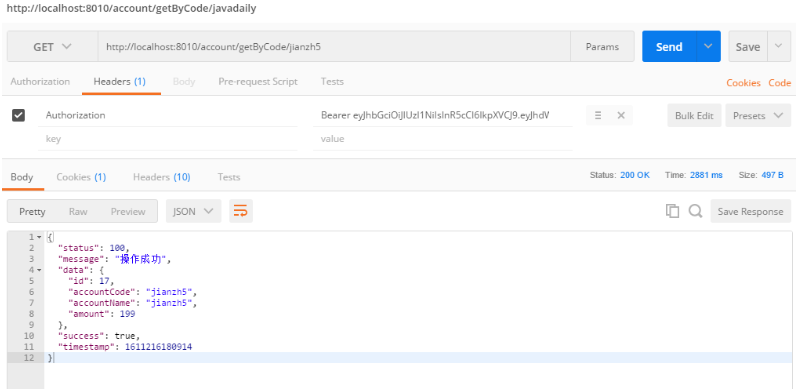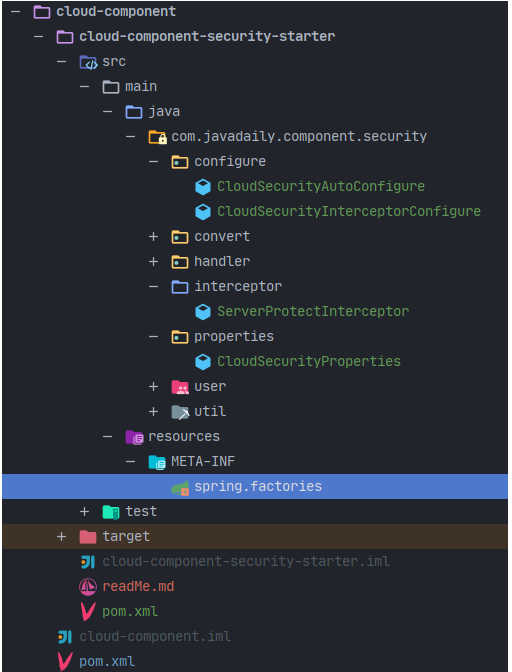

前言


解决方案
-
使用 Kubernetes 部署 在使用 Kubernetes 部署 SpringCloud 架构时,我们给网关的 Service 配置 NodePort,其他后端服务的 Service 使用 ClusterIp,这样在集群外就只能访问到网关了。 -
网络隔离 后端普通服务都部署在内网,通过防火墙策略限制只允许网关应用访问后端服务。 -
应用层拦截 请求后端服务时通过拦截器校验请求是否来自网关,如果不来自网关则提示不允许访问。

实现
实现过程
在网关 cloud-gateway 模块编写网关过滤器
(0)public class GatewayRequestFilter implements GlobalFilter {public Mono<Void> filter(ServerWebExchange exchange, GatewayFilterChain chain) {byte[] token = Base64Utils.encode((CloudConstant.GATEWAY_TOKEN_VALUE).getBytes());String[] headerValues = {new String(token)};ServerHttpRequest build = exchange.getRequest().mutate().header(CloudConstant.GATEWAY_TOKEN_HEADER, headerValues).build();ServerWebExchange newExchange = exchange.mutate().request(build).build();return chain.filter(newExchange);}}在请求经过网关时添加额外的 Header,为了方便这里直接设置成固定值。 建立公共 Starter 模块 cloud-component-security-starter
编写配置类,用于灵活控制服务是否允许绕过网关
public class CloudSecurityProperties {/*** 是否只能通过网关获取资源* 默认为True*/private Boolean onlyFetchByGateway = Boolean.TRUE;}编写拦截器,用于校验请求是否经过网关
public class ServerProtectInterceptor implements HandlerInterceptor {private CloudSecurityProperties properties;public boolean preHandle( HttpServletRequest request, HttpServletResponse response, Object handler){if (!properties.getOnlyFetchByGateway()) {return true;}String token = request.getHeader(CloudConstant.GATEWAY_TOKEN_HEADER);String gatewayToken = new String(Base64Utils.encode(CloudConstant.GATEWAY_TOKEN_VALUE.getBytes()));if (StringUtils.equals(gatewayToken, token)) {return true;} else {ResultData<String> resultData = new ResultData<>();resultData.setSuccess(false);resultData.setStatus(HttpServletResponse.SC_FORBIDDEN);resultData.setMessage("请通过网关访问资源");WebUtils.writeJson(response,resultData);return false;}}public void setProperties(CloudSecurityProperties properties) {this.properties = properties;}}配置拦截器
public class CloudSecurityInterceptorConfigure implements WebMvcConfigurer {private CloudSecurityProperties properties;public void setProperties(CloudSecurityProperties properties) {this.properties = properties;}public HandlerInterceptor serverProtectInterceptor() {ServerProtectInterceptor interceptor = new ServerProtectInterceptor();interceptor.setProperties(properties);return interceptor;}public void addInterceptors(InterceptorRegistry registry) {registry.addInterceptor(serverProtectInterceptor());}}编写 starter 装载类
(CloudSecurityProperties.class)public class CloudSecurityAutoConfigure{public CloudSecurityInterceptorConfigure cloudSecurityInterceptorConfigure() {return new CloudSecurityInterceptorConfigure();}}建立资源文件 spring.factories,配置 Bean 的自动加载
=\com.javadaily.component.security.configure.CloudSecurityAutoConfigure在后端服务配置文件中添加属性配置,默认只能通过网关访问
javadaily:cloud:onlyFetchByGateway: true经过以上几步,一个公共的 Starter 模块就构建完成了。 后端服务引用此公共 Starter 模块即可,以 account-service 为例
<dependency><groupId>com.jianzh5.cloud</groupId><artifactId>cloud-component-security-starter</artifactId></dependency>实现效果
直接访问后端服务接口
http://localhost:8010/account/getByCode/jianzh5返回结果: {"message": "请通过网关访问资源","status": 403,"success": false,"timestamp": 1611660015830}

程序员如何避免陷入“内卷”、选择什么技术最有前景,中国开发者现状与技术趋势究竟是什么样?快来参与「2020 中国开发者大调查」,更有丰富奖品送不停!

☞小米澄清「手机不再支持GMS」;虾米音乐正式关停;《质量效应1》DLC 因源代码损坏而移除 | 极客头条




文章评论